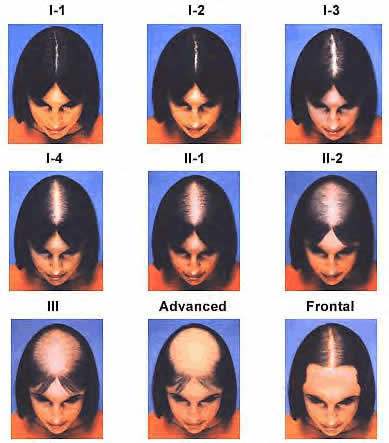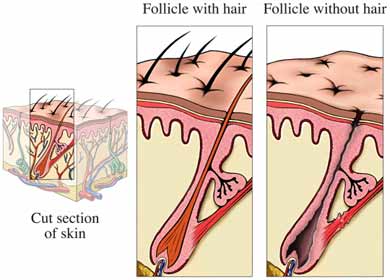Alopecia Information
Click here to scroll to the list of available medications ↓
Alopecia, which is also known as hair loss, can strike men, women, and occasionally teenagers. Alopecia can lead to either partial or complete hair loss. Alopecia may develop gradually. The patient may lose their hair very slowly over time, in patches or chunks around the head, or in patches and chunks in one area of the scalp.
Symptoms of hair loss include an increasing loss of hair. The average individual loses about 100 hairs per day. There are approximately 100,000 hairs on the average human hair. Hair falls out naturally in stages. One strand of hair lives on the head for about 4 or 5 years, where it replaced by a brand new hair after it falls out. Alopecia happens when the number of hairs which fall from the head are replaced slower than average or not at all.

There can be a variety of causes for hair loss. Some hair loss, or hair thinning, happens to both men and women starting around age 30, however it typically is not enough to notice or to cause concern. Causes of alopecia include but are certainly not limited to hormonal changes, emotional stress, physical stress, serious illness, fever, medication, treatments such as chemotherapy, nervous habits like hair pulling or scalp rubbing, excessive shampooing, excessive hair drying, excessive perming or styling especially with heat and chemicals like hair bleach, burns, radiation therapy, immune disorders, or ringworm of the scalp. Any hair loss associated with either childbirth or menopause is almost always temporary. Hair should grow back within a year or two from these causes.
Men who tend not to produce enough testosterone tend to develop alopecia. Genetics and age are other variant risk factors for developing alopecia. The degree which women produce male hormones after menopause influence whether or not the develop alopecia. Men who have undergone castration typically are at risk for balding hair as well.

There are not complications related to alopecia. However, self image and self esteem may or may not be affected by hair loss. Society equates hair loss with a loss of virility and associates hair loss with age. Men who lose their hair early due to heredity or other factors may feel as though they are missing something or being unfairly judged. Women who experience hair loss usually find alopecia having a greater effect on their self esteem, as women are held to a different standard in society than men.
Treatment options for alopecia are considered cosmetic and typically are not covered under medical insurance. Treatment for alopecia can either be a treatment to cover up the problem or a treatment option to attempt to treat the cause of the hair loss. To cover up alopecia a wig is the most common option. They are less expensive than other options and a high quality wig for either men or women can look just like real hair. Many people turn their wig purchases into a hobby of sorts and change their look at will. Hats, scarves, and other head coverings can hide the effects of alopecia without a lot of cost.
A topical medication known as minoxidil has been proven to effectively re-grow hair in both men and women afflicted with alopecia. Results take about six months, and about ½ to 2/3 of alopecia sufferers see results. The medication is only moderately expensive and has shown good results. Many of those who do not see new hair growth do notice that they do not lose additional hair. Minoxidil is created for both men and women.
Hair transplants and other surgical procedures have been considered about 75% effective. A surgeon takes natural growing hair and manually transplants it to places on the scalp where the hair is thinning or gone. This procedure can be done for either men or women. The hair is then expected to re-grow from its new location and for that patient, the alopecia is considered cured in at least 90% of cases. Sometimes medical procedures like these initially grow new hair but then suffer the same fate.
Alopecia is a condition that is harmless, but can cause embarrassment or self esteem issues. This is an unfortunate effect of modern day society that demands perfection from its citizens.